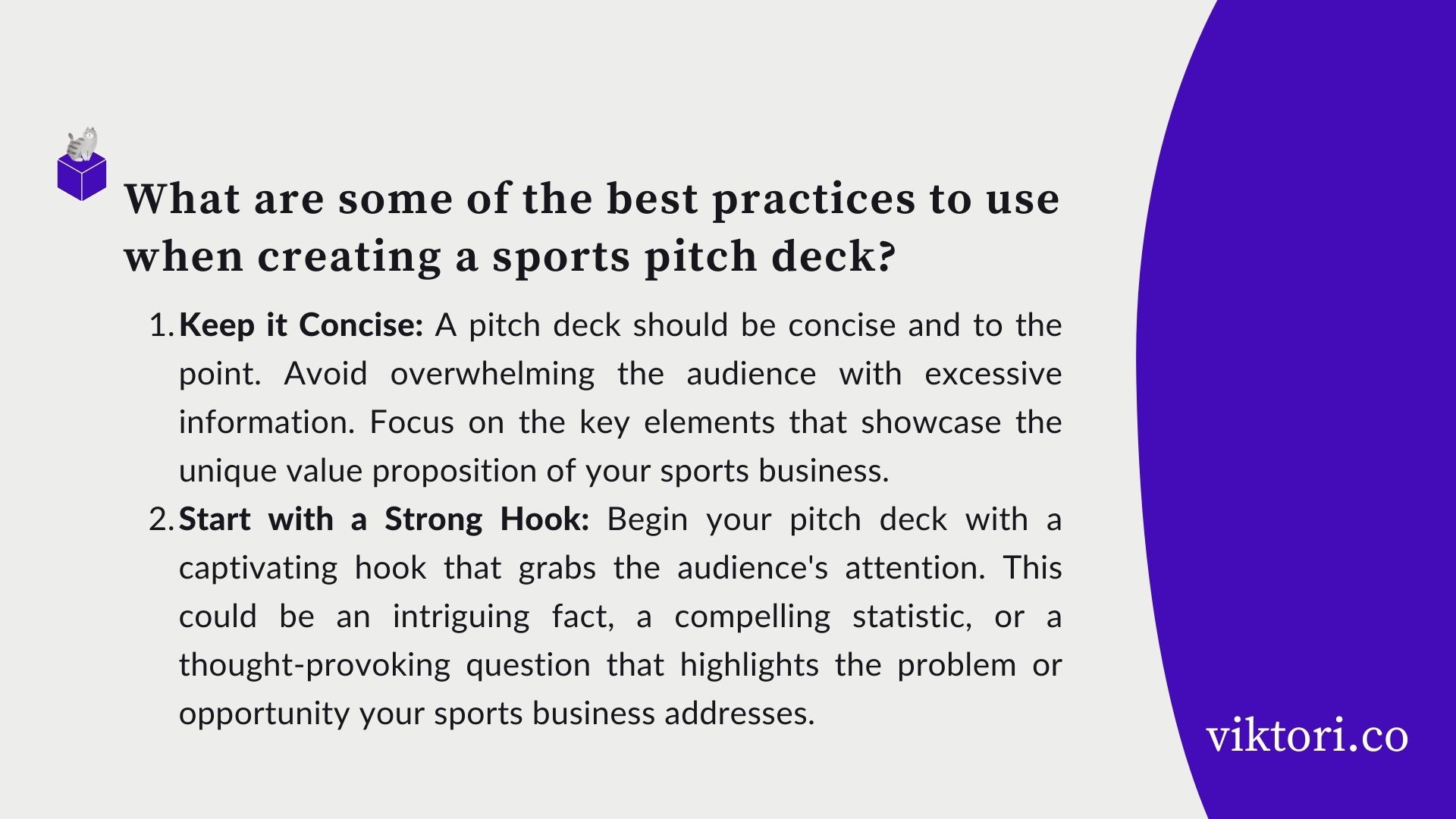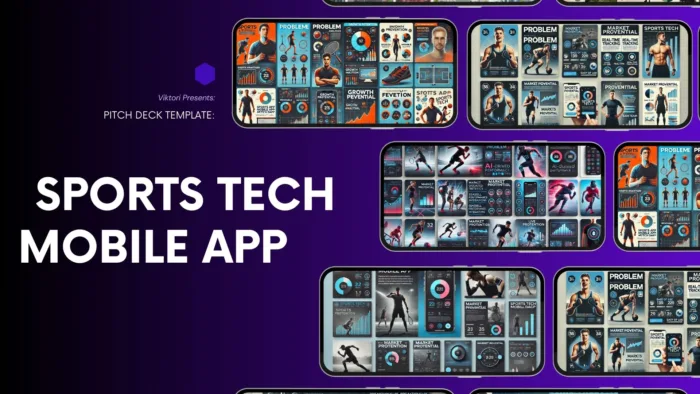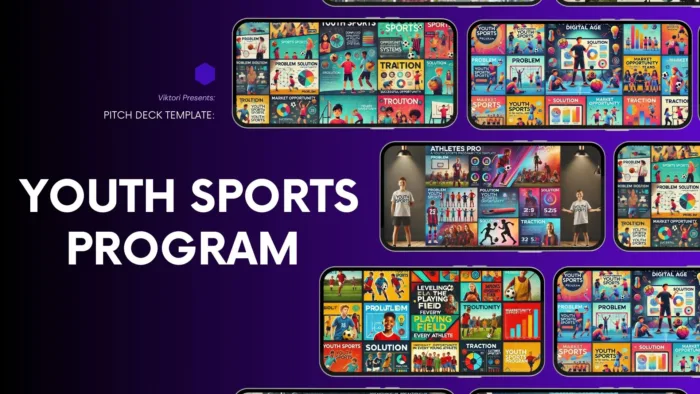You’ve got the next game-changing sports innovation in mind, whether it’s a league, a product, or an app that could revolutionize how athletes and fans connect. But guess what? No one’s buying in just yet.
Here’s the harsh truth: It’s not because your idea isn’t a slam dunk—it’s because your sports pitch deck isn’t up to scratch.
But don’t worry; that’s where I come in.
I’m Viktor, a pitch deck expert and creative business strategist. Over the past 13 years, I’ve helped businesses secure millions of $ in funding thanks to my approach and I’m sharing it here in this pitch deck guide.
In this guide, I’ll coach you through the game plan to create a killer sports pitch deck—no fluff, just straightforward plays that investors can’t resist. Whether you’re aiming for a buzzer-beater investment or gearing up to launch your next sports product, I’ve got the plays mapped out.
Let’s lace up and dive in.
Just In: Youth Sports Pitch Deck Case Study. Find out how we helped TeamzConnect build an investor ready deck.
Get an investor ready pitch deck that gets you funded and saves over 30 hours of your time.
Join 100s of successful entrepreneurs who’ve transformed their pitch decks by using my hands-off approach, which includes: market research, copy, design, financials, narrative and strategy.
1 week turnaround time and less. Special pricing for early stage companies.
The least you will get on this call is 10 actionable tips & strategies to own that next pitch, worth $599, for free.

What Is A Sports Pitch Deck?

A sports pitch deck is a presentation that outlines the key elements of a sports-related business or project to potential investors, partners, or stakeholders. It is a visual tool used to pitch and communicate the value proposition, market opportunity, revenue model, and growth potential of a sports venture.
A sports pitch deck typically includes several slides that cover various aspects of the business, such as market analysis, competitive landscape, unique selling points, team profiles, financial projections, and funding requirements. The goal is to provide a compelling and concise overview of the venture, showcasing its potential for success and generating interest from potential investors.
A well-crafted sports pitch deck combines effective storytelling, data-driven insights, and persuasive visuals to engage the audience and convey the vision and potential of the sports business. It serves as a roadmap for the pitch presentation, guiding the presenter in delivering a coherent and compelling narrative that captivates the audience and motivates them to take action.
How to Create a Sports Pitch Deck Presentation?
Creating a compelling sports pitch deck presentation involves careful planning, thoughtful content creation, and effective visual design. Here are the steps to guide you in creating a sports pitch deck presentation:
- Define Your Objectives: Clarify your goals and what you want to achieve with your sports pitch deck. Are you seeking funding, partnerships, or simply introducing your sports business? Understanding your objectives will help shape the content and focus of your presentation.
- Research and Gather Data: Conduct thorough market research to gather relevant data and insights about the sports industry, target market, competition, and trends. Use reputable sources and statistics to support your claims and strengthen your credibility.
- Structure Your Presentation: Create a logical and engaging structure for your sports pitch deck. Start with a captivating introduction, followed by sections that cover the problem, solution, market analysis, revenue model, team, financials, and any other relevant topics. Ensure a smooth flow between slides to maintain the audience’s interest.
- Craft a Compelling Story: Develop a narrative that tells the story of your sports business. Engage the audience by highlighting the problem or opportunity, showcasing your solution, and emphasizing the unique value proposition. Use storytelling techniques to create an emotional connection and make your presentation memorable.
- Keep it Concise and Visual: Use concise and impactful language to convey your message effectively. Avoid excessive text and focus on key points. Utilize visuals such as images, charts, graphs, and infographics to enhance understanding and make the presentation visually appealing.
- Present Data and Metrics: Incorporate relevant data, market research, and financial projections to support your claims. Present key metrics and growth potential to demonstrate the viability and scalability of your sports venture.
- Showcase Your Team: Introduce the key members of your team and their relevant expertise. Highlight their accomplishments and demonstrate why they are the right people to drive the success of your sports business.
- Design for Impact: Pay attention to the visual design of your sports pitch deck. Use consistent branding, appealing colors, and legible fonts. Ensure that the design elements align with your brand identity and enhance the overall aesthetics of the presentation.
- Practice and Refine: Practice your presentation multiple times to improve your delivery and timing. Seek feedback from trusted colleagues or mentors and make necessary revisions. Refine the content, flow, and design until you are confident in the final version.
- Tailor to the Audience: Customize your sports pitch deck presentation to the specific needs and interests of the audience you are presenting to. Adapt your message to resonate with their expectations, industry knowledge, and investment preferences.
- Prepare for Questions: Anticipate potential questions and objections from the audience. Develop thoughtful and concise responses to address those questions and reinforce the strengths of your sports business.
- Test and Iterate: Test your sports pitch deck presentation with a small audience or trusted advisors. Gather feedback and make any necessary improvements or adjustments based on their input.
A well-crafted sports pitch deck presentation is a dynamic tool that should evolve and adapt as your business progresses. Continuously refine and update your pitch deck to reflect any changes in your business strategy, market conditions, or achievements.
What Does A Sports Pitch Deck Include? The Exact Sports Pitch Deck Slide Structure You Can Steal And Use
A sports pitch deck typically includes several key elements to effectively communicate the value proposition and potential of a sports-related business or project. While the specific content and structure may vary depending on the nature of the venture, here are the common components typically found in a sports pitch deck:
The above is is just a simplified pitch deck version developed as part of our entrepreneurship program for graduate studies.
Founders that are serious about getting the funding they need, opt in for a deck has industry specific content, superb narrative and award winning design like these ones below:









I can help you build that deck with my hands-off process in 7 days or less.
Book a free 30 minute call below if you’re serious about getting an investor ready deck, and we’ll discuss your needs in detail. I’ll help you design the deck, write the content, develop the narrative and flesh out the strategy with financials.

We help 15,000+ founders every month create better pitch decks.
Alternatively, get the custom template for just $69,99.As soon as the payment is processed I’ll send over a quick questionnaire and deliver the deck in 24 hours and less.

Follow us on social for the newest templates:
Slide 1: Elevator Pitch
Objective: Capture attention immediately by clearly communicating what your sports business is, what problem it solves, and why it’s a game-changer.
- Headline: “Revolutionizing [Specific Segment of Sports]: A Game-Changer for [Target Audience]”
- Content:
- One-liner explaining your unique value proposition: “We’re transforming how [specific aspect] is done, making it faster, easier, and more accessible.”
- Highlight your key differentiator in a concise, impactful way: “Think [well-known analogy], but for [your solution].”
- Visuals: High-quality image or graphic that represents your solution or industry.
Slide 2: Investor Highlights
Objective: Give a quick overview of why this is a lucrative opportunity. This slide is like the sports highlight reel—showcase the most impressive stats to hook your investors.
- Headline: “Why Invest in [Your Sports Business]?”
- Content:
- Market size: “$X billion market with a projected growth rate of Y% per year.”
- Revenue potential: “Expected to reach $X million in annual revenue by [year].”
- Traction: “Achieved [specific milestone], with [X] active users and [Y]% month-over-month growth.”
- Competitive advantage: “Unique IP, exclusive partnerships, or proprietary technology.”
- Investment ask: “Raising $X to scale our proven model.”
- Visuals: A clean, visually appealing infographic summarizing the key points.
Slide 3: Introduction
Objective: Establish credibility by introducing yourself and your company while highlighting what sets you apart.
- Headline: “Meet [Your Company Name]”
- Content:
- Brief overview of your sports business and its mission.
- Highlight your unique selling proposition (USP): “We’re the first to do [innovative solution] in [specific segment].”
- Brief personal introduction: “I’m Viktor, an expert with over a decade in the sports and tech industries.”
- Visuals: Use your logo, a photo of yourself, and any relevant branding elements.
Slide 4: Problem Statement
Objective: Clearly define the pain point in the sports industry that you’re solving. Make it relatable to the audience.
- Headline: “The Challenge in [Sports Industry/Segment]”
- Content:
- Define the problem: “Coaches and athletes struggle with [specific issue].”
- Quantify the pain: “Over X% of [target market] face this challenge, resulting in [negative outcome].”
- Consequences of not addressing the problem: “If left unresolved, [specific impact].”
- Visuals: Include an impactful image or graph illustrating the problem.
Slide 5: Solution
Objective: Present your product or service as the ideal solution to the problem you’ve identified.
- Headline: “Introducing [Your Solution]: The Answer to [Problem]”
- Content:
- Explain how your solution addresses the pain points: “Our platform reduces [problem] by [specific method].”
- Highlight key features and benefits: “Automated, scalable, and user-friendly.”
- Show real-world application: “Already implemented by [notable client].”
- Visuals: Use a product demo screenshot, flowchart, or before-and-after illustration.
Slide 6: Market Analysis
Objective: Show investors that you have a deep understanding of your target market and its potential.
- Headline: “A $X Billion Market Ripe for Innovation”
- Content:
- Market size and growth rate.
- Target segments: “Focusing on [specific segments] with an estimated [X]% market share by [year].”
- Trends driving market growth: “Rise of digital fitness platforms, increasing demand for analytics.”
- Visuals: Use graphs or charts to display market size and trends.
Check out some of the essential 101 guides:
Mastering the Financial Projections Slide: Turning First Impressions into Lasting Opportunities
You’re convinced your startup is the next big thing, but somehow, your pitch keeps landing…
Creating an Impactful Traction Slide for Your Investor Pitch Deck: A Startup Guide
You’ve got the next unicorn startup brewing, but here’s the harsh reality: your traction slide…
Mastering the Pitch Deck Solution Slide
You’ve got the next big thing, whether it’s a revolutionary SaaS platform or the future…
Mastering Your Pitch Deck Go-to-Market Slide: A Step-by-Step Guide For Startups
Ever pitched your groundbreaking idea, only to be met with blank stares and polite nods?…
Pitch Deck Problem Slide: Template, Examples, Guide
You’ve got a groundbreaking business idea, but somehow, the investors aren’t biting. Here’s the kicker:…
The Elevator Pitch Slide | Examples, Template, Tips & Guide
Imagine having a revolutionary idea that could disrupt an entire industry. You’ve done the hard…
Slide 7: Competitive Analysis
Objective: Highlight your competitive edge and demonstrate how you’ll stand out in the market.
- Headline: “Outperforming the Competition”
- Content:
- Identify main competitors and their strengths/weaknesses.
- Highlight your differentiators: “Unlike [Competitor A], we offer [unique feature].”
- Include a comparison matrix showcasing your advantages.
- Visuals: A table or chart comparing your solution to competitors.
Slide 8: Revenue Model
Objective: Explain how you plan to make money and show your business’s potential for profitability.
- Headline: “Proven Revenue Streams for Sustainable Growth”
- Content:
- Revenue streams: “Subscription, in-app purchases, and partnerships.”
- Pricing strategy: “Tiered pricing model targeting [different customer segments].”
- Monetization plan: “Projected $X million in revenue by [year] with a Y% profit margin.”
- Visuals: A financial graph or flowchart of your revenue streams.
Slide 9: Marketing and Customer Acquisition Strategy
Objective: Showcase your plan to attract and retain customers.
- Headline: “Winning Strategies for Market Penetration”
- Content:
- Key marketing channels: “Social media ads, influencer partnerships, SEO.”
- Customer acquisition cost vs. lifetime value: “CAC: $X, LTV: $Y.”
- Campaign examples: “Leveraging partnerships with [brand] to increase reach.”
- Visuals: Marketing funnel diagram or a sample campaign overview.
Slide 10: Team and Expertise
Objective: Highlight the strength of your team to build credibility.
- Headline: “Meet the Team Behind the Vision”
- Content:
- Highlight core team members, their roles, and relevant experience.
- Showcase any industry experts or advisors involved.
- Explain why your team is uniquely positioned to succeed.
- Visuals: Photos of team members with brief bios.
Slide 11: Financial Projections
Objective: Convince investors that your business has strong financial potential.
- Headline: “Forecasting Growth and Profitability”
- Content:
- Key financial metrics: “Projected revenue, gross margin, and profitability over the next 3-5 years.”
- Highlight break-even point and ROI.
- Use charts to show revenue growth, expenses, and net income.
- Visuals: Bar charts and line graphs to illustrate projections.
Slide 12: Milestones and Achievements
Objective: Showcase your progress to date and future roadmap.
- Headline: “Major Wins and the Path Ahead”
- Content:
- Highlight key milestones: “Launched beta version, signed [number] users, secured partnerships.”
- Future goals: “Expanding to [new market] and reaching [milestone] by [year].”
- Visuals: Timeline or roadmap graphic.
Slide 13: Funding Requirements
Objective: Clearly articulate your funding needs and how the funds will be used.
- Headline: “Fueling Our Next Phase of Growth”
- Content:
- Amount requested: “Raising $X to scale operations.”
- Use of funds: “X% for product development, Y% for marketing, Z% for team expansion.”
- Expected outcomes from the investment: “Achieving [specific milestone] within [timeframe].”
- Visuals: Pie chart of fund allocation.
Slide 14: Exit Strategy
Objective: Provide potential exit strategies to assure investors of ROI.
- Headline: “Clear Path to Return on Investment”
- Content:
- Potential exits: “Acquisition by [industry giants], IPO, or strategic buybacks.”
- Case studies of similar exits in your industry.
- Visuals: Illustrative icons representing exit strategies.
Slide 15: Appendix
Objective: Include any supporting materials that strengthen your pitch.
- Content: Testimonials, case studies, media mentions, and product demos.
- Visuals: Screenshots, testimonials in quote format, or press logos.
While this structure provides a starting point, feel free to rearrange or modify the order of slides to best showcase the unique aspects of your sports business. Customize the content, visuals, and messaging to effectively convey your value proposition and captivate your audience.
Related Sports Pitch Deck Templates
14 Slide Fantasy Sports Pitch Deck Template | Google Slides
So, you’re obsessed with fantasy sports, right? You’ve got that unbeatable lineup, the one you…
10 Slide Wordle-Style Chess Pitch Deck Template
So, you’re into chess, but you’re not feeling the excitement that should come with it,…
Personal Wellness App Pitch Deck Case Study
The wellness and health technology industry is booming, with global market size expected to reach…
12 Slide Fresno Indoor Soccer Center Pitch Deck Template
Alright, here’s the deal. You love soccer, and so do we. But finding a consistent,…
13 Slide Sports Tech Mobile App Pitch Deck Template
Alright, so you’ve got an idea for a sports tech app. It’s sleek, innovative, and…
16 Slide Youth Sports Program Pitch Deck Template
You know how kids today are more attached to their screens than to sports? It’s…
12 Slide Netball Team School Pitch Deck Template
Ever felt like your school’s sports program is missing something? Maybe it’s that spark, that…
Must Read: Fitness for Moms Pitch Deck Template
Hey there! You’ve got a little one on the way or just welcomed a new…
Sport Psychologist App Pitch Deck Template
You’re an athlete, or maybe you just pretend to be one on weekends. Either way,…
16 Slide Football Talk Show Podcast Pitch Deck Template
So, you think you’ve got the next big idea for a football talk show—something that’s…
16 Slide Sports Teams Strategic Investments Pitch Deck Template
You’ve been in the game for years—helping pro sports teams score strategic partnerships. But when…
12-Slide Basketball Gym Pitch Deck Template That Shoots for Success
Alright, let’s cut to the chase. You’ve got this killer idea for a basketball gym…
12 Slide Activewear Pitch Deck Template
You’ve got the next big thing in activewear, right? Your designs are sleek, your fabrics…
17 Slide Martial Arts Organization Pitch Deck Template
Let’s kick off with a vision that’s all about discovering and nurturing the next generation…
15 Slide Tennis Documentary Pitch Deck Template
Alright, let’s set the stage. You’re about to present something special—a documentary that dives deep…
15 Slide Sports Pitch Deck Template
Let’s kick things off with a strong first impression. You’re about to present a project…
15 Slide Sports Training Pitch Deck Template
So, you’ve got the next big thing in sports training – maybe the app that’ll…
12 Slide Champions Arena Pitch Deck Template
Alright, so you’ve got this mind-blowing idea for a TV game show—think “American Ninja Warrior”…
10 Slide Sports Social Network Pitch Deck Template
You’ve got a killer idea for a sports social network, one that’s going to make…
15 Slide Yoga Sports League Pitch Deck Template
Are you ready to revolutionize the world of wellness and sports with your unique yoga…
Get Your Copy Of My Pitch Deck Template That Helped Clients Get Millions In Funding
To captivate the interest of buyers and investors in the realm of sports products and services, a precise and comprehensive pitch deck plays a vital role. Luckily, crafting an impactful sports deck revolves around skillfully choosing the right slides, and platforms like Canva and Google Slides offer multiple templates to assist you.
Nonetheless, these ready-made templates may not align perfectly with your brand, necessitating considerable time and effort to tailor them accordingly.
Thankfully, there’s a superior alternative. Utilizing a custom-written template not only saves time but also ensures your deck resonates with your brand identity.
Through this approach, my clients have successfully developed exceptional sports pitch decks in half the time, paving the way for securing funding, deals, and investments.
If you seek a streamlined process for creating a pitch deck tailored to your sports-related business, reach out to gain access to the winning template that has propelled others toward remarkable success.
Why is it important to understand your audience when creating a sports pitch deck?
Understanding your audience is crucial when creating a sports pitch deck for several reasons:
- Tailored Messaging: Different investors or stakeholders have varying interests, preferences, and knowledge levels. By understanding your audience, you can tailor your messaging to resonate with them. You can emphasize specific aspects of your sports business that align with their investment criteria or address their pain points. This increases the chances of capturing their attention and generating interest in your pitch.
- Relevance and Context: Knowing your audience allows you to provide relevant and contextual information. By understanding their industry expertise and background, you can customize your pitch deck to speak their language and present data and insights that are meaningful to them. This enhances their understanding of your business and increases the perceived value of your proposition.
- Addressing Concerns and Objections: Each audience may have unique concerns, objections, or questions. By anticipating these concerns and addressing them proactively in your pitch deck, you can instill confidence and overcome any potential barriers to investment. Understanding your audience helps you identify their potential objections and provide compelling counterarguments or evidence to alleviate their doubts.
- Emphasizing Value Proposition: Different audiences may have different priorities when evaluating a sports business. By understanding your audience, you can highlight the aspects of your venture that align with their priorities. This ensures that your pitch deck effectively communicates the value proposition and benefits that are most important to your target audience.
- Establishing Rapport: Understanding your audience helps you establish rapport and build a connection with them. By demonstrating that you have taken the time to understand their needs and interests, you can create a sense of trust and credibility. This can significantly enhance the overall impression of your pitch and increase the likelihood of a positive reception.
Understanding your audience allows you to customize your pitch deck to their specific needs, address their concerns, and emphasize the aspects of your sports business that are most relevant and appealing to them. It enhances the effectiveness of your pitch and increases the chances of securing investment or partnership opportunities.
Why is it important to craft a compelling story when creating a sports pitch deck?
Crafting a compelling story is essential when creating a sports pitch deck for several reasons:
- Capturing Attention: A compelling story captures the audience’s attention from the start. In a competitive landscape, where investors and stakeholders are exposed to numerous pitch decks, a well-crafted story stands out and piques their interest. It creates an emotional connection and makes your pitch more memorable.
- Engaging the Audience: A story engages the audience on a deeper level compared to a mere presentation of facts and figures. It draws them into the narrative, making them more invested in your sports business and its potential. When the audience is engaged, they are more likely to pay attention, ask questions, and consider your proposition seriously.
- Demonstrating Vision and Passion: A compelling story showcases your vision and passion for your sports business. It helps investors understand the “why” behind your venture and how it aligns with your personal values and aspirations. When you demonstrate genuine enthusiasm and conviction, it becomes easier to inspire confidence in your idea and attract support.
- Making Complex Concepts Accessible: A well-crafted story can simplify complex concepts and make them more accessible to a wide range of audiences. It breaks down technical or industry-specific jargon into relatable terms, enabling better comprehension and understanding. This is especially important when presenting to potential investors who may not have deep knowledge of the sports industry.
- Differentiating from Competitors: A compelling story sets your sports business apart from competitors. It allows you to highlight your unique selling points, the problem you are solving, and the impact you aim to make. By telling your story in a compelling way, you create a distinct identity and position your venture as something special and worthwhile.
- Building Trust and Credibility: A well-crafted story builds trust and credibility. It demonstrates that you have a deep understanding of your industry, target market, and customers. It showcases your ability to navigate challenges, adapt, and innovate. When investors feel that you have a compelling story backed by expertise and a strong foundation, they are more likely to trust your capabilities and consider investing in your sports business.
To help you improve your narrative, check this selection on the best books for pitching. The authors have won billions in $ thanks to their ability to create stories when pitching and are sharing their methods with you.
A compelling story in your sports pitch deck helps you stand out, engage the audience, demonstrate vision and passion, simplify complex concepts, differentiate from competitors, and build trust and credibility. It adds depth and personality to your pitch, increasing the chances of resonating with investors and stakeholders on an emotional level.
How important are design and visuals when creating a sports pitch deck?
Design and visuals play a significant role in creating an impactful sports pitch deck. Here’s why they are important:
- Visual Appeal: A visually appealing pitch deck grabs the attention of the audience right from the start. It creates a positive first impression and entices the viewers to explore the content further. Engaging design elements, attractive colors, and high-quality visuals make your pitch deck visually stimulating, enhancing the overall experience for the audience.
- Communication Efficiency: Visuals have the power to convey information more efficiently than text alone. Well-designed charts, graphs, infographics, and images can simplify complex data and concepts, making them easier to understand and remember. Visuals can also aid in storytelling by evoking emotions and illustrating key points, helping the audience connect with your sports business on a deeper level.
- Branding and Professionalism: Consistent branding throughout your pitch deck creates a cohesive and professional image. It reflects attention to detail and a level of polish that instills confidence in the audience. Well-executed design elements, such as a logo, color scheme, and typography, help establish a strong brand identity and make your sports business more memorable.
- Information Retention: Visuals enhance information retention and recall. Studies have shown that people remember information better when it is presented visually. By incorporating visuals into your pitch deck, you increase the likelihood that your key messages, data points, and value propositions will stick with the audience long after the presentation is over.
- Differentiation and Impact: A visually appealing pitch deck sets you apart from competitors. It demonstrates a level of professionalism, creativity, and attention to detail that can make a lasting impression on investors and stakeholders. A well-designed pitch deck can evoke positive emotions and create a sense of excitement and anticipation, increasing the impact of your presentation.
- Accessibility and Universal Understanding: Visuals can transcend language barriers and facilitate universal understanding. When presenting to a diverse audience or international investors, relying on visual elements can help convey your message effectively, even if English is not their first language. Visuals have the power to communicate ideas and concepts in a universally understandable way.
Hold on. You might want to check my list on the best presentation and communication books...
These are crucial books that will help you improve the design and structure of your decks and presentations, besides improving your delivery and skyrocketing your confidence when facing investors. Check them out below.

Design and visuals are essential in creating a sports pitch deck that is visually appealing, communicates information effectively, enhances brand identity, aids in information retention, differentiates you from competitors, and ensures universal understanding. Investing time and effort into thoughtful design can significantly elevate the impact and success of your pitch deck presentation.
How to prepare for questions and objections when presenting a sports pitch deck?
Preparing for questions and objections is a crucial aspect of presenting a sports pitch deck. Here are some steps to help you effectively prepare:
- Anticipate Common Questions: Put yourself in the shoes of potential investors and stakeholders and think about the questions they are likely to ask. Consider aspects such as your market, competition, revenue model, growth strategy, and risks. Research common questions asked in the sports industry and compile a list of potential inquiries.
- Know Your Numbers: Be thoroughly familiar with the financial projections, market data, and key metrics presented in your pitch deck. Understand the assumptions and calculations behind your numbers. This will enable you to respond confidently and provide detailed explanations when questioned about financials or market data.
- Conduct a Mock Q&A Session: Enlist the help of colleagues, mentors, or industry experts to conduct a mock Q&A session. Practice answering a variety of questions and objections that may arise. This exercise will help you refine your responses, improve your delivery, and identify any areas that need further clarification or research.
- Prepare Concise and Clear Responses: Aim to provide concise and clear responses to questions and objections. Avoid being defensive or argumentative. Instead, focus on addressing the concerns raised by providing relevant information, data, and examples. Use storytelling techniques or real-world case studies to illustrate your points and support your claims.
- Maintain a Positive Attitude: Approach questions and objections with a positive attitude. View them as opportunities to showcase your knowledge, expertise, and problem-solving abilities. Stay calm, confident, and respectful throughout the Q&A session, even if faced with challenging or critical questions.
- Practice Active Listening: During the actual presentation, listen attentively to the questions being asked. Make sure you fully understand the question before responding. If needed, ask for clarification or repetition. By actively listening, you demonstrate respect for the audience’s concerns and can provide more targeted and relevant responses.
- Be Honest and Transparent: If you don’t have an immediate answer to a question, it’s okay to admit it. Be honest and transparent, and commit to following up with the information at a later time. This shows your integrity and commitment to providing accurate and reliable information.
- Stay Flexible and Open to Feedback: Be prepared for feedback, suggestions, and alternative viewpoints. Embrace constructive criticism and use it as an opportunity to refine your pitch and business strategy. Investors appreciate entrepreneurs who are open-minded and adaptable to feedback.
Preparation is key when it comes to handling questions and objections. By anticipating potential inquiries, knowing your numbers, practicing responses, and maintaining a positive attitude, you will be well-equipped to address the audience’s concerns and confidently navigate the Q&A session.
What are the best practices when creating a sports pitch deck?

When creating a sports pitch deck, consider the following best practices to make it compelling and effective:
- Keep it Concise: A pitch deck should be concise and to the point. Avoid overwhelming the audience with excessive information. Focus on the key elements that showcase the unique value proposition of your sports business.
- Start with a Strong Hook: Begin your pitch deck with a captivating hook that grabs the audience’s attention. This could be an intriguing fact, a compelling statistic, or a thought-provoking question that highlights the problem or opportunity your sports business addresses.
- Tell a Compelling Story: Craft a narrative that engages the audience emotionally. Share the journey of your sports business, highlighting the challenges, successes, and the impact you aim to make. Connect with the audience on a personal level and evoke their interest and excitement.
- Highlight the Problem and Solution: Clearly define the problem or opportunity in the sports industry that your business addresses. Clearly present your solution and explain how it solves the identified problem. Showcase the benefits and unique features of your sports business.
- Know Your Market: Conduct thorough market research and demonstrate a deep understanding of the sports industry and its trends. Identify your target market, audience, and potential customers. Present compelling data and insights that support the market potential for your sports business.
- Showcase Traction and Milestones: Highlight any traction, achievements, or significant milestones your sports business has accomplished. This could include partnerships, customer acquisition, revenue growth, or notable recognition. Such achievements provide credibility and validate the potential of your business.
- Visual Appeal: Utilize engaging design and visuals to enhance the visual appeal of your pitch deck. Use charts, graphs, images, and infographics to present information in a visually appealing and easily digestible manner. Ensure consistency in branding, color scheme, and typography throughout the deck.
- Provide Financial Projections: Include financial projections that demonstrate the revenue potential and profitability of your sports business. Present realistic and data-driven forecasts, supported by market research and sound assumptions. Show the scalability and return on investment potential.
- Showcase the Team: Introduce the key members of your team and their relevant experience in the sports industry. Highlight their expertise, accomplishments, and how their skills align with the goals of your sports business. Investors often value the strength and capabilities of the team.
- End with a Clear Call to Action: Conclude your pitch deck with a clear call to action. Specify the next steps you expect from the audience, whether it’s setting up a meeting, requesting more information, or considering an investment. Provide contact details and encourage follow-up communication.
- Practice and Refine: Before presenting your pitch deck, practice your presentation delivery multiple times. Seek feedback from trusted individuals who can provide constructive criticism. Refine your pitch based on the feedback received, ensuring clarity, flow, and impact.
Remember, these best practices are general guidelines. Tailor your pitch deck to your specific sports business, target audience, and objectives. The key is to create a compelling narrative, effectively communicate your value proposition, and leave a lasting impression on the audience.
What nobody will tell you: Crucial considerations to keep in mind when developing your sports pitch deck and business
10 insights. These are things no advisor, startup event organizer or coach will tell you for free. We’ve done the research and combined it with our experience to give you these insights with no strings attached.
Market Analysis
When developing a sports pitch deck, incorporating insights from the latest market analysis and trends in the sports industry is crucial. Here’s a summary of the current trends and how they can be integrated into your pitch deck:
- Market Dynamics: The sports industry has experienced significant growth, with a 4.3% revenue growth in U.S. wholesale sales of athletic footwear, apparel, sports, and fitness equipment in 2022. However, this growth rate is lower than the GDP, indicating a more challenging environment (SFIA). Additionally, there has been a recent dip in demand for durable goods like sports equipment, likely impacting future sales (McKinsey).
- Consumer Behavior Shifts: Brand relevance is increasingly important, with consumers now more driven by brand than by functionality, design, or price (McKinsey). This shift emphasizes the need for a strong brand narrative in your pitch.
- Digital and Physical Blending: The sports industry is seeing a blend of digital and physical experiences, which is reshaping fan engagement and creating new revenue streams (Deloitte Global). This trend should be considered when developing digital strategies within your pitch deck.
- Private Equity Investment and Women’s Sports: There’s growing interest from private equity in sports, and women’s professional sports are gaining ground. This opens opportunities for new investment types and expanding markets (Deloitte US).
- Technology Infusion: Technology continues to play a crucial role, from innovations in fan engagement to enhancing athlete performance. This offers opportunities for tech-integrated sports business models (Deloitte Global).
- Economic and Social Challenges: The sports industry is not immune to broader economic and social challenges, including inflation and potential recession impacts. These factors should be addressed in your pitch deck, particularly in financial projections and risk management strategies (SFIA).
- Sustainability and Responsibility: With increasing focus on sustainability and social responsibility, sports organizations are encouraged to adopt responsible and sustainable approaches. This aspect can be a differentiator in your pitch deck (Deloitte US).
Actions to Take for Your Sports Pitch Deck:
- Highlight Brand Strength: Emphasize your brand’s unique identity and value proposition in the context of current consumer trends.
- Incorporate Digital Strategies: Include innovative digital engagement methods, leveraging the blending of physical and digital experiences.
- Address Economic Challenges: Prepare for potential economic downturns with robust financial planning and risk management strategies.
- Focus on Emerging Markets: Highlight the potential in women’s sports and new investment opportunities.
- Integrate Sustainability: Demonstrate a commitment to sustainability and social responsibility within your business model.
- Leverage Technology: Show how technology will be used to enhance the experience for fans and athletes.
By integrating these insights and actions into your sports pitch deck, you’ll be addressing both current market trends and potential investor concerns, making your pitch more compelling and relevant to today’s sports industry landscape.
Target Audience
Incorporating insights about target audience identification into a sports pitch deck is crucial for demonstrating an understanding of the market and for tailoring your approach to meet specific fan interests and behaviors. Here are some key aspects to consider, drawing from recent trends and best practices in sports marketing:
- Audience Engagement and Brand Sponsorships: Fans are highly receptive to brand sponsorships, with 81% considering sports sponsorships effective. Moreover, 77% view a brand more favorably if it sponsors their favorite team. This highlights the importance of aligning your pitch with brands that resonate with your target audience and leveraging sponsorships effectively (ZipDo).
- Influencer Marketing and User-Generated Content: Influencer marketing is increasingly impactful in sports, with 61% of viewers trusting product recommendations from influencers. Using platforms like TikTok’s Creator Marketplace can help identify influencers that align with your brand and target audience. Additionally, leveraging user-generated content can significantly enhance fan engagement and create authentic connections (Porter & Wills).
- Digital Trends and First-Party Data: As digital platforms evolve, collecting first-party data becomes essential for understanding and engaging your target audience effectively. This involves identifying fan preferences, behaviors, and demographics to deliver personalized and meaningful content (Greenfly).
- Personalization and Engaging Content: Utilizing data analytics for personalized marketing and creating engaging content are key strategies. This includes developing targeted campaigns based on fan insights and incorporating interactive elements like quizzes, polls, and immersive experiences (KU Online Sport Management).
- Challenges in Digital Sports Marketing: Navigating data privacy concerns, overcoming information overload, and engaging diverse audiences are significant challenges. Addressing these in your pitch deck can demonstrate a comprehensive understanding of the current digital landscape and how to effectively reach and engage a diverse fan base (KU Online Sport Management).
- Emerging Opportunities in Women’s Sports: The media coverage for female athletes is currently only 4%, indicating a significant opportunity for growth and engagement in this area. Including strategies for tapping into this underrepresented market can be a unique angle for your pitch deck (ZipDo).
In summary, your sports pitch deck should focus on understanding and leveraging the dynamics of fan engagement, utilizing digital trends and data analytics for personalized marketing, and exploring underrepresented areas such as women’s sports for new opportunities. Emphasizing these aspects can create a compelling and effective pitch deck tailored to the current sports marketing landscape.
Unique Value Proposition
Creating a unique value proposition (UVP) is crucial for a sports pitch deck as it defines what sets your sports product, service, or brand apart from the competition. It’s a clear statement that describes the benefits of your offer, how you solve your customers’ needs, and what distinguishes you from others.
Here are key aspects to consider when developing a UVP for a sports pitch deck, along with suggested actions:
- Address a Specific Need in the Sports Market: Your UVP should clearly state how your product or service addresses a unique need or problem in the sports industry. This could be an innovative technology, a unique approach to sports training, or a new fan engagement strategy.
- Highlight What Makes You Different: Emphasize what makes your offer different and better than the alternatives. This could be your advanced technology, unique partnerships, superior quality, or exclusive access to certain sports content or experiences.
- Focus on Benefits, Not Just Features: Rather than just listing the features of your product or service, highlight the benefits these features bring to your customers, whether they are sports fans, athletes, or sports organizations.
- Back Your Claims with Data or Testimonials: Use market research, customer testimonials, or case studies to support your claims. This adds credibility to your UVP and demonstrates that there is a real demand or positive response to what you are offering.
- Make It Simple and Clear: Your UVP should be easy to understand and articulate. Avoid jargon or technical terms that might not be clear to all potential investors or partners.
- Tailor It to Your Target Audience: Your UVP should resonate with your specific target audience in the sports industry. This could mean focusing on the technological aspects for a tech-savvy audience or emphasizing community and fan engagement for sports marketers.
Actions to Take:
- Conduct Market Research: Understand the needs and preferences of your target audience in the sports industry.
- Analyze Competitors: Identify what competitors are offering and how your product or service differs.
- Craft a Clear Statement: Develop a concise UVP statement that encapsulates the essence of what makes your offer unique and valuable.
- Test and Refine: Share your UVP with a sample of your target audience and get feedback. Refine it based on this feedback to ensure it resonates well.
- Integrate into Your Pitch Deck: Make your UVP a central part of your pitch deck, ensuring it’s clearly communicated in your introduction and supported throughout the presentation.
Remember, a well-crafted UVP can be the difference between a pitch deck that resonates and one that falls flat, especially in the competitive world of sports.
Revenue Models
Understanding and presenting diverse revenue models is a crucial component of a sports pitch deck. Different revenue streams can significantly impact the financial success and sustainability of a sports-related venture. Here are some key revenue models specific to the sports industry, along with suggested actions for incorporating them into your pitch deck:
- Ticket Sales: Ticket sales for games, matches, and events are a traditional and significant source of revenue. This includes season tickets, premium seating, and VIP experiences.
- Action: Analyze and present pricing strategies, potential for dynamic pricing, and opportunities to increase ticket sales through promotions and special events.
- Broadcasting Rights: Selling broadcasting rights to television networks and online streaming platforms can be extremely lucrative, especially for popular sports and leagues.
- Action: Research and outline potential partnerships with media companies and the value of your sports content to these broadcasters.
- Sponsorships and Advertising: Revenue from sponsorships and advertising is a major component, including deals with brands for stadium naming rights, advertising during broadcasts, and sponsorships of teams or events.
- Action: Identify potential sponsorship opportunities and develop strategies to attract sponsors by highlighting audience demographics and engagement rates.
- Merchandising and Licensing: Selling licensed merchandise, such as apparel, equipment, and memorabilia, provides a significant income stream.
- Action: Explore and propose strategies for merchandise sales, both online and offline, and potential licensing deals.
- Digital Media and Content: Monetizing digital content through subscriptions, pay-per-view events, or advertising on websites and social media platforms.
- Action: Develop a digital media strategy that includes content creation and distribution, and outline potential revenue from these channels.
- Fan Engagement and Experiences: Revenue from fan engagement activities such as fantasy sports, gaming, and interactive fan experiences both online and in-stadium.
- Action: Present innovative fan engagement ideas and how they can be monetized, such as through app development or in-stadium experiences.
- Private Equity and Investment: Attracting investment from private equity firms, individual investors, or crowdfunding.
- Action: Create an investment proposal highlighting the potential returns and growth opportunities in your sports venture.
- Partnerships and Collaborations: Collaborations with other organizations, clubs, or leagues to host events or create new sporting ventures can open up additional revenue streams.
- Action: Identify and propose potential partnerships and collaborative projects, outlining the financial benefits of these alliances.
Incorporating Revenue Models into Your Pitch Deck:
- Market Analysis: Include an analysis of the current market and potential for revenue growth in each of these areas.
- Financial Projections: Provide detailed financial projections showing how these revenue streams can be realized and their impact on the overall financial health of the venture.
- Case Studies: Reference successful examples or case studies of similar sports ventures that have effectively utilized these revenue models.
- Strategic Plan: Outline a clear strategic plan on how you intend to tap into these revenue streams, including timelines and milestones.
A comprehensive understanding and presentation of these revenue models will not only demonstrate your knowledge of the sports industry but also provide potential investors with a clear picture of how your venture will generate income and achieve sustainability.
Partnerships and Sponsorships
Brand partnerships and sponsorship strategies are pivotal components of a sports pitch deck, as they can provide significant financial support and enhance brand visibility. Here are some insights and actions to consider when developing this section of your pitch deck:
- Identifying Potential Partners and Sponsors: Focus on companies and brands whose target audience aligns with your sports venture’s audience. This includes brands actively involved in sports, health, lifestyle, and those seeking to associate with the sports industry’s dynamic and engaging environment.
- Action: Conduct market research to identify potential partners whose branding and target demographics align with your venture. Create a list of potential sponsors along with a tailored approach for each.
- Creating Attractive Sponsorship Packages: Develop a variety of sponsorship packages that offer different levels of exposure and benefits. This can range from title sponsorships to smaller, more targeted opportunities.
- Action: Design sponsorship packages with varied price points and benefits. Include options like branding at events, advertising on team gear, digital promotion, and VIP experiences.
- Demonstrating Audience Engagement and Reach: Sponsors are particularly interested in the size and engagement level of your audience. They want to ensure their brand will reach and resonate with a large and engaged group of sports fans.
- Action: Gather and present data on your audience size, demographics, engagement rates on social media, and any other relevant metrics that demonstrate the value of your audience to potential sponsors.
- Leveraging Digital and Social Media Platforms: In the digital age, online presence and social media engagement can be extremely appealing to sponsors. They often look for innovative digital marketing opportunities.
- Action: Outline your digital and social media strategy, showcasing how sponsors can benefit from online exposure, including potential for branded content, sponsored posts, and digital campaigns.
- Developing Long-term Relationships: Emphasize the importance of building long-term partnerships with sponsors rather than one-off deals. Long-term relationships can provide sustained funding and offer opportunities for deeper brand integration.
- Action: Create a strategy for nurturing long-term relationships with sponsors, including regular updates, joint marketing efforts, and opportunities for renewing and expanding their sponsorship.
- Customization and Flexibility: Be prepared to customize sponsorship opportunities to meet the specific needs and goals of potential sponsors. Flexibility can be a key selling point.
- Action: Develop a flexible approach to sponsorships, showing a willingness to tailor packages to meet specific sponsor objectives and needs.
- Measuring and Reporting ROI: Sponsors will want to know the return on their investment. Be prepared to measure and report on the effectiveness of sponsorship activities.
- Action: Plan for how you will measure and report the impact of sponsorships, such as increased brand visibility, audience growth, and engagement metrics.
In your pitch deck, these strategies should be clearly articulated, demonstrating an understanding of what potential sponsors look for and how your sports venture can meet these needs. Include case studies or examples of successful sponsorships to illustrate the potential benefits and effectiveness of your approach.
Social Media and Digital Marketing
Incorporating social media and digital marketing strategies into a sports pitch deck is essential, given the significant role these platforms play in engaging fans, promoting events, and enhancing brand visibility. Here are some key strategies along with actions to take:
- Targeted Advertising: Utilize the sophisticated targeting tools available on platforms like Facebook, Instagram, and Twitter to reach specific audience segments. This includes targeting by demographics, interests, location, and behaviors related to sports.
- Action: Develop targeted advertising campaigns tailored to different audience segments. Use analytics to refine targeting strategies continuously.
- Content Marketing: Develop a content marketing strategy that includes a mix of engaging, informative, and promotional content. This can include behind-the-scenes footage, athlete interviews, training tips, and live event coverage.
- Action: Create a content calendar that outlines the types of content to be shared, ensuring a consistent and varied content stream.
- Engagement Through Storytelling: Use storytelling to build emotional connections with your audience. Share stories about athletes, fans, and key moments that resonate with sports enthusiasts.
- Action: Develop a series of storytelling campaigns that showcase different aspects of your sports brand, athletes, or events.
- Leveraging Influencers and Athletes: Partner with influencers and athletes who have a strong following in the sports community. Their endorsement can greatly amplify your message and reach.
- Action: Identify and collaborate with influencers and athletes whose followers align with your target audience. Develop a strategy for content creation and sharing.
- Interactive and Immersive Experiences: Utilize technologies like augmented reality (AR) and virtual reality (VR) to create immersive fan experiences. This can include virtual tours of sports venues, AR games, and VR experiences of live events.
- Action: Explore partnerships with AR/VR technology providers to create unique digital experiences for fans.
- User-Generated Content: Encourage fans to create and share their own content related to your sports brand or events. This not only increases engagement but also provides authentic content for your channels.
- Action: Launch campaigns or contests that encourage user-generated content, and feature this content on your platforms.
- Email Marketing: Use email marketing to keep fans informed and engaged. This includes newsletters, event announcements, and exclusive offers.
- Action: Build an email subscriber list and develop a series of email campaigns tailored to different segments of your audience.
- Data-Driven Insights: Leverage data analytics to gain insights into fan behavior and preferences. Use these insights to refine your marketing strategies and personalize fan experiences.
- Action: Implement analytics tools to track engagement and conversions, and use this data to inform your marketing decisions.
- SEO and Online Visibility: Optimize your website and content for search engines to enhance online visibility and attract organic traffic.
- Action: Conduct keyword research specific to the sports industry and optimize your website content, blog posts, and online materials for these keywords.
In your pitch deck, ensure that these strategies are presented with a clear plan of action, including timelines, expected outcomes, and how they align with your overall business objectives. Demonstrating a deep understanding of digital marketing in the sports context can significantly enhance the appeal of your pitch to potential investors or partners.
Legal and Ethical Considerations
Addressing legal and ethical considerations is crucial in a sports pitch deck. These factors not only ensure compliance with laws and regulations but also build trust and credibility with stakeholders. Here are key areas to focus on and actions to take:
- Intellectual Property Rights: Ensure that your business respects intellectual property laws, especially regarding branding, logos, and merchandise.
- Action: Conduct thorough research to ensure that your trademarks and logos don’t infringe on existing intellectual property. Consider seeking legal advice to secure your intellectual property rights.
- Contractual Agreements: Highlight your adherence to contractual obligations, especially in dealings with athletes, sponsors, and partners.
- Action: Prepare standard contract templates that are fair and compliant with legal standards. Detail your approach to honoring contracts in your pitch.
- Compliance with Sports Governing Bodies: Sports organizations often have to comply with rules and regulations set by governing bodies.
- Action: Show your understanding and compliance with these regulations. If applicable, describe how your business aligns with the ethical guidelines of relevant sports governing bodies.
- Athlete Welfare and Safety: Emphasize your commitment to athlete welfare, including physical and mental health, and safety standards.
- Action: Develop and present policies on athlete welfare and safety. This might include training protocols, healthcare support, and mental health resources.
- Fair Play and Integrity in Sports: Address the importance of maintaining integrity in sports, including issues like doping, match-fixing, and corruption.
- Action: Implement strict policies against unethical practices and outline how your organization will uphold the integrity of the sport.
- Data Protection and Privacy: With the increasing use of digital platforms, ensuring the privacy and protection of user data is vital.
- Action: Develop a robust data protection policy in compliance with regulations like GDPR. Highlight this policy in your pitch to demonstrate your commitment to user privacy.
- Diversity and Inclusion: Show your commitment to promoting diversity and inclusion within your organization and in your sports initiatives.
- Action: Create a diversity and inclusion policy and showcase initiatives or programs that promote these values.
- Environmental Sustainability: The environmental impact of sports events and organizations is increasingly under scrutiny.
- Action: Develop and share your strategies for reducing the environmental footprint of your sports activities, such as waste management and energy-efficient practices.
In your pitch deck, clearly articulate these legal and ethical considerations, providing evidence of your compliance and commitment. This could include policies, compliance certificates, or examples of ethical practices in action. Demonstrating a proactive approach to these aspects can significantly enhance the credibility and attractiveness of your proposal to investors, partners, and other stakeholders.
Sustainability and Social Responsibility
Incorporating sustainability and social responsibility into a sports pitch deck is increasingly important, reflecting a growing consumer demand for environmentally friendly and socially responsible practices in the sports industry. Here are key trends and actions to consider:
- Consumer Demand for Sustainability: A significant motivating factor for sports organizations to adopt sustainable practices is consumer demand. Around 48% of organizations are driven by customer demands for environmental sustainability, with an additional 43% motivated by the desire to maintain a green image. This trend indicates that sustainability is not only a moral imperative but also a business necessity (ISPO.com).
- Focus on Greenwashing: There’s a growing emphasis on authenticity in sustainability claims. Many consumers are skeptical of greenwashing and are looking for genuine efforts. This includes affiliations with reputable seals and certifications like bluesign, Global Organic Textile Standard (GOTS), or Fair Wear Foundation (FWF) to validate sustainability claims (ISPO.com).
- Neo-Ecology in the Sports Industry: The concept of neo-ecology, combining ecological considerations with economic activities, is becoming a central factor in the sports industry. This trend reflects a shift towards a green and sustainable economy and is something that companies should no longer neglect (ISPO.com).
- Circular Economy: The sports industry is increasingly embracing the circular economy model, focusing on resource efficiency and the life cycle of products. This includes designing products with their end-of-life in mind and keeping resources in use for as long as possible (ISPO.com).
- Sustainable Finance: The financial sector’s activities related to reducing environmental and climate damage, promoting social participation, and sustainable corporate governance are becoming crucial. This trend is aligned with the broader ESG (Environmental, Social, Governance) criteria (ISPO.com).
- Impact on Women’s Sports: There’s an expectation that women’s sports revenues will grow significantly, with a focus on aligning investments in women’s sports with ESG agendas. This trend suggests that focusing on women’s sports can be part of a broader sustainability and social responsibility strategy (The Sustainability Report).
In your sports pitch deck, highlighting these trends and your strategies for addressing them can demonstrate forward-thinking and responsible management. Actions include:
- Developing sustainability policies and practices that align with consumer expectations.
- Seeking certifications and affiliations that validate your sustainability claims.
- Integrating sustainable practices into your supply chain and product life cycle.
- Focusing on sustainable finance and investment strategies.
- Emphasizing the role of women’s sports in your overall sustainability and social responsibility agenda.
By addressing these aspects, your pitch deck can showcase a commitment to sustainability and social responsibility, aligning with the current trends and consumer demands in the sports industry.
Technology
Integrating technology in sports is a dynamic and rapidly evolving field, crucial for the success of any sports-related venture. Here are some key trends and actions for your sports pitch deck:
- Generative AI: The use of generative AI in sports technology is growing. It can be used for analyzing and optimizing strategies, predicting outcomes, and designing training regimens tailored to individual athletes. Additionally, it can help in content creation, like generating pre- and post-game coverage, athlete biographies, and more (Infront Lab).
- Action: Explore how generative AI can enhance your sports venture, from performance analytics to content creation.
- NFTs and Digital Ticketing: The sports industry is seeing innovative uses of NFTs, especially in ticketing. NFT tickets provide more security and help reduce fraud, illegal reselling, and scalping. They also offer insights into who is attending events (Infront Lab).
- Action: Consider implementing NFT ticketing for events to improve security and gain valuable fan insights.
- Data Collection and Distribution: Collecting and using data effectively is becoming increasingly important. With the shift towards zero-party data collection, sports organizations are focusing on building their own databases for more personalized fan experiences (Infront Lab).
- Action: Develop a robust data collection strategy, focusing on fan engagement tools to build a comprehensive fan database.
- Evolution of Sports Content: There’s a growing trend towards personalized and behind-the-scenes sports content. Platforms like Netflix have popularized sports documentaries, which has increased interest in niche sports and personal athlete stories (Infront Lab).
- Action: Create engaging, behind-the-scenes content that resonates with fans, possibly exploring documentary-style presentations.
- Tech-Backed Stadiums: Advances in technology are enhancing in-stadium experiences. Technologies like augmented reality and flexible ticketing subscriptions are becoming more prevalent (Infront Lab).
- Action: If your venture involves event management, consider incorporating advanced technologies to enhance the in-stadium experience.
- First-Party Data and Personalization: The focus on first-party data collection is critical. It enables sports organizations to understand their fans better and deliver individualized messages and content (Greenfly).
- Action: Implement strategies for first-party data collection from various digital touchpoints to understand and engage your audience effectively.
- Influencer and Athlete Marketing: There’s a shift in athlete sponsorships, moving towards less commercialized and more authentic on-field activations combined with social media campaigns (Greenfly).
- Action: Leverage influencer and athlete marketing to create authentic brand connections and fan engagement.
In your pitch deck, emphasize how these technology trends can be integrated into your sports venture to enhance performance, fan engagement, content creation, and overall experience. Showcasing a forward-thinking approach to technology can significantly strengthen your pitch to potential investors or partners.
Case Studies
Integrating case studies and success stories into your sports pitch deck is crucial for demonstrating real-world examples of success in the sports industry. These stories can provide insights into effective strategies, lessons learned, and the potential for growth and innovation in the sector. Here are some key areas and actions to consider:
- Brand Relevance and Sustainability: The sporting goods industry has seen a shift towards brand relevance and sustainability. Consumers increasingly favor brands with strong identities and sustainable practices. This highlights the importance of building a strong brand and a commitment to sustainability in your venture.
- Action: Highlight your brand’s unique identity and sustainability initiatives. Show how these align with consumer trends and preferences (McKinsey).
- Innovative Strategies in Challenging Times: With changes in consumer spending, sporting goods companies are adopting innovative strategies like smart pricing, supply chain resilience, and strengthening brand communications. This approach helps navigate economic challenges while positioning for growth.
- Action: Present innovative strategies your venture is adopting to overcome challenges and capitalize on market opportunities (McKinsey).
- Investment Trends in Women’s Sport: Women’s sports have seen significant investment and growth, with predictions that revenues will exceed $1 billion globally. This trend demonstrates the rising value and potential of women’s sports assets.
- Action: If your venture involves women’s sports, emphasize the growth potential and investment trends in this area (City A.M.).
- Emergence of Personal Branding in Sports: The rise of personal branding in sports, especially among student athletes, is a notable trend. For instance, Athlo agncy successfully leveraged strategic partnerships and grassroots marketing initiatives to monetize personal brands for college athletes.
- Action: Showcase how your venture could leverage personal branding strategies to enhance athlete marketability and revenue generation (Starter Story).
In your pitch deck, use these case studies and success stories to illustrate the potential of your venture. Show how your strategies align with successful trends in the sports industry and how you plan to capitalize on these opportunities. This approach not only adds credibility to your pitch but also provides a clear vision of the potential success your venture can achieve.
Financial Planning
Incorporating financial planning and investment-seeking strategies into a sports pitch deck is vital in today’s sports industry. The sports sector continues to attract significant investment interest, fueled by factors like the potential for high returns and the prestige associated with sports ownership. Here’s an overview of the current landscape and actionable steps for your pitch deck:
- Investor Interest in Sports: Despite a challenging macroeconomic climate, the sports sector is expected to continue drawing capital in 2023. This interest is driven by the sports industry’s historical growth and the unique opportunities it presents. More than 200 mergers and acquisitions (M&A) transactions were completed in the sports sector in 2022, indicating a robust market for investment (Deloitte).
- Growing Appeal of Women’s Sports: Women’s sports are increasingly becoming a focus for investment, with predictions of revenue exceeding $1 billion globally. This trend underscores the rising value of women’s sports assets and their potential for growth (City A.M.).
- Robust Sports Deal Market: The sports deal market is expected to remain strong in 2023, with significant transactions like the sale of Chelsea Football Club for $5.4 billion illustrating the continued appeal of sports team ownership. New revenue streams from areas like media rights and sports betting are supplementing traditional income sources, making the sector more lucrative (KPMG).
Actions to Include in Your Pitch Deck:
- Highlight the Market Potential: Emphasize the sports industry’s growth potential and appeal to investors. Include data and trends that showcase the sector’s resilience and growth prospects.
- Focus on Women’s Sports: If applicable, highlight the opportunities in women’s sports. Present data and trends that support the growing interest and investment in this area.
- Outline Revenue Streams: Detail the various potential revenue streams for your sports venture. This could include traditional sources like ticket sales and sponsorships, as well as emerging areas like media rights and digital offerings.
- Investment Strategy: Present a clear investment strategy that outlines how funds will be used, expected returns, and how you plan to mitigate risks.
- Long-term Financial Planning: Show how your venture plans for long-term sustainability and growth. This could include strategies for reinvestment, scaling operations, and adapting to market changes.
By focusing on these areas and actions, your sports pitch deck will present a well-rounded and compelling case for investment, aligned with current trends and investor interests in the sports industry.
Crafting a Narrative
Creating an effective sports pitch deck involves more than just compiling data and visuals; it’s about crafting a narrative that resonates with your audience and showcases your sports business in the best light possible. Here are some key points and actions to take:
- Understand Your Audience: Tailoring your pitch to the interests, preferences, and knowledge level of your audience is crucial. This helps in emphasizing aspects of your sports business that align with their investment criteria or address their concerns (Viktori).
- Craft a Compelling Story: Engage your audience with a story that builds anticipation and interest. Your story should demonstrate your vision, passion, and the unique aspects of your sports venture. This helps in making your pitch memorable and differentiates it from others (Prezi).
- Simplicity in Design: Keep your slides simple and uncluttered. Overly complex or crowded slides can overwhelm and confuse the audience. Use legible fonts, appropriate sizes, and maintain consistency in your design. Each slide should focus on a single key point to ensure your message is clear and easily absorbed (Soft Skill Success, Prezi).
- Effective Use of Visuals: Use visuals like graphs and charts to simplify and effectively communicate complex data. However, ensure these visuals do not overcrowd your slides. Consistency in colors and fonts is also important to maintain clarity and reinforce your brand identity (Prezi).
- Presentation Skills: Your body language, voice control, and engagement with the audience are as important as the content of your pitch. Practice your pitch to ensure it flows well and fits within time constraints. Be prepared to address questions and concerns, and make eye contact to build a connection with your audience (Prezi).
- Data and Validation: Back up your claims with market research, growth projections, or case studies. Using real-world examples enhances your credibility and validates your business model (Prezi).
- The Ask: Clearly state what you are seeking from your audience, whether it’s funding, support, or partnership. Make sure this is communicated effectively towards the end of your pitch (Prezi).
In summary, a successful sports pitch deck is not just about the information you present but also how you present it. By understanding your audience, crafting a compelling story, keeping the design simple yet effective, and honing your presentation skills, you can create a pitch deck that not only informs but also inspires and engages your audience.
Use these insights and make a winning pitch. If you want to talk about them, reach out to me and book a call.
How to creatively pitch your sports startup?
Capturing the attention of your audience in a sports startup pitch can be a game-changer. Here are some novel and bold ideas that can make your pitch memorable and engaging:
- Live Demonstration: If your sports startup is about a new product or technology, perform a live demo on stage. For instance, if it’s a new fitness device, demonstrate it in action. This live interaction can be more compelling than just talking about the product.
- Wear the Sports Gear: If applicable, wear the sports gear related to your startup. For example, if you’re pitching a new type of running shoe, wear them on stage. This can be a great conversation starter and visually emphasizes your product.
- Interactive VR/AR Experience: If your startup is about a digital or virtual reality sports experience, set up a live VR/AR demonstration for the audience. Let a few members of the audience try it out during your presentation to create a buzz.
- Athlete Endorsement: If possible, bring a well-known athlete associated with your sport to the pitch. They could either be physically present or join via a live video call. An endorsement from a credible athlete can significantly boost your pitch’s appeal.
- Storytelling with a Twist: Start your presentation with a compelling, personal story related to sports but add a twist that ties directly into your business idea. This could be a surprising or humorous anecdote that grabs attention and highlights the need for your product or service.
- Audience Participation: Engage the audience in a mini sports-related activity or challenge that demonstrates your product’s use or the problem it solves. For example, a quick interactive game or physical activity related to your product can energize the room.
- Dynamic Visual Effects: Use high-energy video or animation at the beginning of your pitch that showcases the sports industry’s excitement. This could be a montage of athletic achievements, the thrill of sports, or the problem your startup intends to solve.
- Bold Claim or Challenge: Start with a bold statement or challenge the existing norms in the sports industry. This could be a provocative question or a declaration about how your startup will revolutionize a particular aspect of sports.
- Use of Props: Use creative props that symbolize your sports startup. For example, if your product is a new kind of golf ball, start your pitch by hitting a golf ball into the audience (safely) or juggling golf balls while you introduce your concept.
- Shock Factor: Begin with a shocking statistic or fact about the sports industry that highlights the problem your startup addresses. This can immediately pique the interest of the audience and set the stage for your solution.
Remember, the key to a successful pitch is not just the creativity but also its relevance to your product or service. The idea should enhance your message, not overshadow it.
Sports Pitch Examples For Inspiration
1. FitPlay: The Ultimate Fitness Gaming Platform
- Slide 1: The Vision
- FitPlay: Merging fitness and gaming to revolutionize the way people exercise
- Creating an immersive and engaging fitness experience through gamification
- Slide 2: The Problem
- Growing sedentary lifestyle and lack of motivation to exercise regularly
- Traditional fitness routines can be monotonous and uninspiring
- Slide 3: The Solution
- FitPlay’s interactive gaming platform that transforms workouts into fun and challenging experiences
- Integration with popular gaming consoles, wearable devices, and fitness equipment
- Slide 4: The Market
- Expanding market of fitness enthusiasts and gamers seeking novel exercise options
- Potential to tap into the multi-billion dollar gaming and fitness industries
- Slide 5: Revenue Streams
- Subscription-based model for access to FitPlay’s gaming library and workout programs
- In-app purchases for additional features and virtual goods
- Partnerships with fitness equipment manufacturers and gaming studios
- Slide 6: The Team
- Seasoned founders with expertise in gaming, fitness, and technology
- Advisory board comprising industry veterans and fitness expert
- Slide 7: Milestones & Roadmap
- Platform development and beta testing
- Launch strategy and user acquisition plan
- Expansion into new markets and integration with emerging technologies
- Slide 8: Funding Request & Use
- Funding required to finalize platform development, marketing, and expansion
- Detailed breakdown of investment allocation
2. FanConnect: Enhancing the Sports Fan Experience
- Slide 1: The Vision
- FanConnect: Redefining the way sports fans engage with their favorite teams
- Leveraging technology to create immersive, personalized, and interactive experiences
- Slide 2: The Problem
- Traditional sports viewing experiences lack interactivity and personalization
- Limited avenues for fans to connect with their favorite teams and players
- Slide 3: The Solution
- FanConnect’s mobile app, providing real-time updates, exclusive content, and interactive features
- Augmented reality experiences, fan contests, and social engagement tools
- Slide 4: The Market
- Enormous global fan base across various sports, leagues, and teams
- Potential to collaborate with sports organizations, sponsors, and broadcasters
- Slide 5: Revenue Streams
- In-app advertising and sponsorship opportunities
- Premium subscription for exclusive content and features
- Merchandise sales and partnerships
- Slide 6: The Team
- Seasoned executives with expertise in sports technology, fan engagement, and marketing
- Partnerships with sports organizations, media companies, and technology providers
- Slide 7: Milestones & Roadmap
- App development and beta testing
- User acquisition and marketing strategy
- Expansion to new sports markets and integration with emerging technologies
- Slide 8: Funding Request & Use
- Funding required to enhance app features, marketing efforts, and expand user base
- Detailed breakdown of investment utilization
SportsHub: All-in-One Sports Management Platform
- Slide 1: The Vision
- SportsHub: Empowering sports organizations and athletes with a comprehensive management platform
- Streamlining operations, enhancing performance, and maximizing fan engagement
- Slide 2: The Problem
- Fragmented sports management processes, leading to inefficiencies and missed opportunities
- Limited tools for athletes and teams to connect with fans and optimize their performance
- Slide 3: The Solution
- SportsHub’s integrated platform, encompassing athlete management, team operations, and fan engagement features
- Advanced analytics, scheduling tools, and social media integration
- Slide 4: The Market
- Vast market of sports organizations, teams, and athletes seeking efficient management solutions
- Potential to collaborate with sports governing bodies, sponsors, and talent agencies
- Slide 5: Revenue Streams
- Subscription-based model for sports organizations and athletes
- Advertising and sponsorship opportunities within the platform
- Data analytics services and premium features
- Slide 6: The Team
- Accomplished team with expertise in sports management, technology, and business development
- Strategic partnerships with sports organizations and technology providers
- Slide 7: Milestones & Roadmap
- Platform development and testing
- Client acquisition and onboarding strategy
- Continuous enhancement of features and expansion into new sports markets
- Slide 8: Funding Request & Use
- Funding required to drive platform development, marketing efforts, and customer acquisition
- Comprehensive breakdown of investment allocation
Pitch Decks From Sports Startups: Pitch Decks Examples
- Peloton: A leading home fitness platform that offers connected exercise bikes and treadmills, along with interactive fitness classes streamed live and on-demand.
- DraftKings: A popular daily fantasy sports and sports betting platform that allows users to compete and win real money prizes based on the performance of professional athletes.
- Fanatics: A global sports merchandise and apparel retailer that partners with major sports leagues and teams to provide fans with official licensed merchandise.
- Zwift: An interactive online platform that combines indoor cycling and running with virtual reality, allowing users to train, compete, and connect with other athletes in immersive virtual worlds.
- FuboTV: A live streaming platform focused on sports and entertainment, offering a wide range of sports channels, live events, and on-demand content to cord-cutters and sports enthusiasts.
- Hudl: A sports performance analysis platform that provides coaches and athletes with tools for video analysis, performance tracking, and team management.
- Catapult Sports: A leading provider of sports performance analytics and wearable technology, helping athletes and teams optimize their training, performance, and injury prevention.
- TeamSnap: A sports team management software that simplifies communication, scheduling, and organization for coaches, players, and parents involved in recreational and competitive sports.
- Sportradar: A global sports data and content provider that delivers real-time sports statistics, odds, and media content to media companies, sportsbooks, and sports leagues worldwide.
- Sportlogiq: A sports analytics company that uses advanced computer vision and AI technology to provide detailed insights and statistics for various sports, enabling teams and media outlets to make data-driven decisions.
Questions That Investors Ask Sports Pitch Deck Owners:
When investors review a sports pitch deck, they often ask a variety of questions to gain a deeper understanding of the business and its potential. Here are some common questions that investors may ask sports pitch deck owners:
- What problem does your sports business solve, and how big is the market opportunity?
- Who is your target audience, and how do you plan to reach and engage them?
- What is your unique value proposition or competitive advantage in the sports industry?
- How do you plan to generate revenue and achieve profitability?
- What is your customer acquisition strategy, and how will you retain and grow your customer base?
- Who are your main competitors, and what sets you apart from them?
- How do you plan to scale and expand your sports business in the future?
- What are the key risks associated with your business, and how do you plan to mitigate them?
- What is the background and expertise of your team members, and how do their skills align with your business goals?
- What milestones or achievements have you accomplished so far, and what are your future milestones?
- What are your financial projections, including revenue forecasts, expenses, and expected return on investment?
- Have you secured any partnerships, sponsorships, or licensing agreements that demonstrate market validation or potential growth opportunities?
- How do you plan to adapt to industry trends, technological advancements, and changes in consumer behavior?
- What is your exit strategy for investors? Are you targeting an acquisition, IPO, or other exit opportunities?
- How much funding are you seeking, and how do you plan to allocate the investment capital?
These are just some of the questions that investors may ask during the evaluation of a sports pitch deck. It’s important to thoroughly research and prepare thoughtful responses to these questions to demonstrate your understanding of the market, your business strategy, and your ability to address potential concerns.
My Final Thoughts
As we reach the final descent of this airline pitch deck guide, it’s time to reflect on the remarkable journey we’ve embarked upon.
Armed with the insights and strategies outlined within these slides, you are now equipped to navigate the turbulence of the aviation industry with confidence and finesse. Remember, a well-crafted pitch deck is your passport to capturing the attention of buyers, investors, and stakeholders.
By harnessing the power of compelling storytelling, captivating visuals, and a data-driven approach, you can soar above the clouds of competition.
Whether you’re aiming to revolutionize eco-friendly travel, disrupt regional commuting, or redefine luxury in the skies, let your pitch deck be a testament to your vision, innovation, and unwavering determination.
Embrace the opportunity to take off and make a lasting impact in the world of aviation.
Buckle up, fellow aviators of entrepreneurial success, and prepare for an exhilarating flight toward new horizons. Safe travels, and may your pitch deck reach unprecedented heights of achievement!
You got this.
But if you don’t got it:
Join hundreds of successful entrepreneurs who’ve transformed their pitch decks with my help.
Let me develop an investor ready deck by using my hands-off approach, which includes: market research, copy, design, financials, narrative and strategy.
One week turnaround time.
The least you will get is 10 actionable tips & strategies to own that next presentation, worth $599, for free.

More Resources
Take a look at my pivotal guide on pitch decks, which has enabled my clients to secure funding in the millions.
Within its pages, you will be guided through a fail-proof step-by-step approach that empowers you to craft a remarkable pitch deck. This comprehensive resource encompasses the following essential elements:
- Detailed insights on building the slides, including the elevator pitch slide, financials slide, and more.
- Inspiring examples of startup pitch decks that have achieved significant success.
- In-depth understanding of what investors truly seek in a pitch deck.
- Clear definition of what a pitch deck should embody to effectively communicate your vision.
- Guidance on what a pitch deck should avoid to maintain focus and impact.
- A collection of valuable tips and tricks to elevate your pitch presentation to the next level.
By immersing yourself in this guide, you will gain the knowledge and expertise needed to create a compelling pitch deck that captivates investors and unlocks funding opportunities.


























